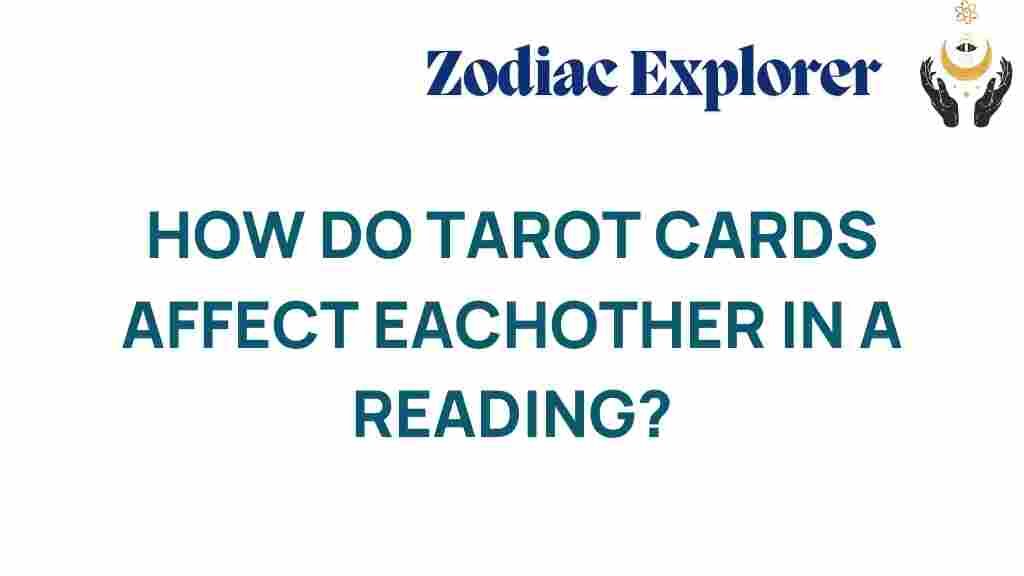Unraveling the Mysteries: How Tarot Cards Influence Each Other
For centuries, tarot cards have captivated seekers of wisdom and insight, serving as a powerful tool for divination and spirituality. While many are familiar with the meanings of individual cards, the true magic of a tarot reading lies in the intricate reading dynamics that emerge when cards interact with one another. This article explores how card interactions influence tarot interpretation, guiding your intuitive reading and enhancing your fortune-telling practices.
Understanding Tarot Card Interactions
Each tarot card is rich in symbolism, representing various aspects of life, emotions, and situations. However, when cards are laid out in a spread, their interactions create a tapestry of meaning that goes beyond their individual definitions. Understanding these interactions is key to unlocking deeper insights during your readings.
- Complementary Cards: Some cards enhance the meanings of others, offering clarity and support.
- Contradictory Cards: These can create tension in a reading, highlighting internal conflicts or mixed messages.
- Reinforcing Cards: When multiple cards reflect similar themes, they amplify the message being conveyed.
- Contextual Cards: Surrounding cards can influence the interpretation of a specific card, changing its meaning based on the situation.
The Science of Reading Dynamics
To effectively understand how tarot cards influence each other, it is essential to grasp the concept of reading dynamics. This involves recognizing how the position of a card in a spread, its relationship to other cards, and the question posed can all affect its significance.
1. The Spread Layout
The layout of your spread is crucial. Different spreads serve different purposes:
- Three-Card Spread: Ideal for quick insights or yes/no questions.
- Celtic Cross Spread: Offers a comprehensive overview of a situation.
- Relationship Spread: Focuses on dynamics between two individuals.
Each position in a spread represents a different aspect of the query, influencing how the cards interact with one another.
2. Card Positioning and Meaning
The placement of each card in the spread determines its role. For instance:
- Past Position: Reflects influences that have shaped the current situation.
- Present Position: Represents current energies and circumstances.
- Future Position: Indicates potential outcomes based on current trajectories.
Understanding these roles helps in interpreting how the cards communicate with each other.
Step-by-Step Guide to Interpreting Card Interactions
Now that we understand the basics, let’s delve into a step-by-step process for interpreting card interactions during a tarot reading.
Step 1: Set Your Intention
Before beginning your reading, set a clear intention or question. This helps focus the energies and guides the tarot interpretation.
Step 2: Choose Your Spread
Decide on the spread you will use. The spread will dictate how many cards you draw and how they will interact with one another. For example, a simple three-card spread can provide insight into the past, present, and future of a situation.
Step 3: Draw Your Cards
Shuffle your deck while concentrating on your question. Draw the cards and place them in the chosen spread layout.
Step 4: Observe Card Interactions
Begin by interpreting each card independently. Then, look for interactions:
- Identify any complementary or contradictory meanings.
- Note the suits and numbers of the cards to identify patterns.
- Pay attention to major arcana cards, as they often signify significant themes.
Step 5: Synthesize the Information
Combine the individual interpretations with the dynamics observed. How do the cards work together to form a cohesive narrative? This synthesis is where the true power of tarot cards lies.
Common Troubleshooting Tips
Sometimes, you may find it challenging to interpret the interactions between cards. Here are some troubleshooting tips to enhance your readings:
- Trust Your Intuition: Allow your initial feelings about the cards to guide your interpretation.
- Revisit Card Meanings: If you’re unsure, consult your guidebook for deeper meanings.
- Practice with Different Decks: Different decks can provide fresh perspectives on the same cards.
- Engage with the Cards: Spend time meditating on individual cards and their meanings.
Enhancing Your Intuitive Reading
Building your skills in intuitive reading is essential for mastering the reading dynamics of tarot. Here are some ways to enhance your intuition:
- Journaling: Write down your readings and the insights you gain over time.
- Daily Pulls: Draw one card every day to connect with the deck and understand its energies.
- Group Readings: Share readings with friends to see how others interpret the same cards.
- Study Symbolism: Delve deeper into the symbolism of each card, enhancing your understanding of their meanings.
Conclusion: The Art of Tarot Reading
Understanding how tarot cards influence each other through their interactions is essential for effective tarot interpretation. By recognizing the dynamics at play within your spreads, you can unlock deeper insights and guidance for yourself and others. Whether you are using tarot for fortune-telling or personal spirituality, the journey of learning and interpreting card interactions is a rewarding path.
As you continue to practice and refine your skills, remember that each reading is unique, and the cards hold endless possibilities. Embrace the journey of exploration, and let your intuition guide you.
For further reading on tarot techniques, check out this comprehensive guide. Additionally, to deepen your understanding of tarot symbolism, consider exploring this resource.
This article is in the category Myths and created by ZodiacExplorer Team
